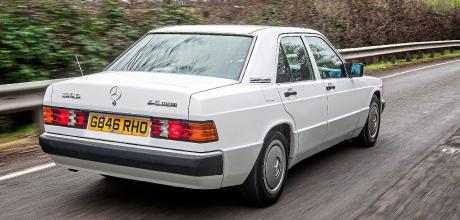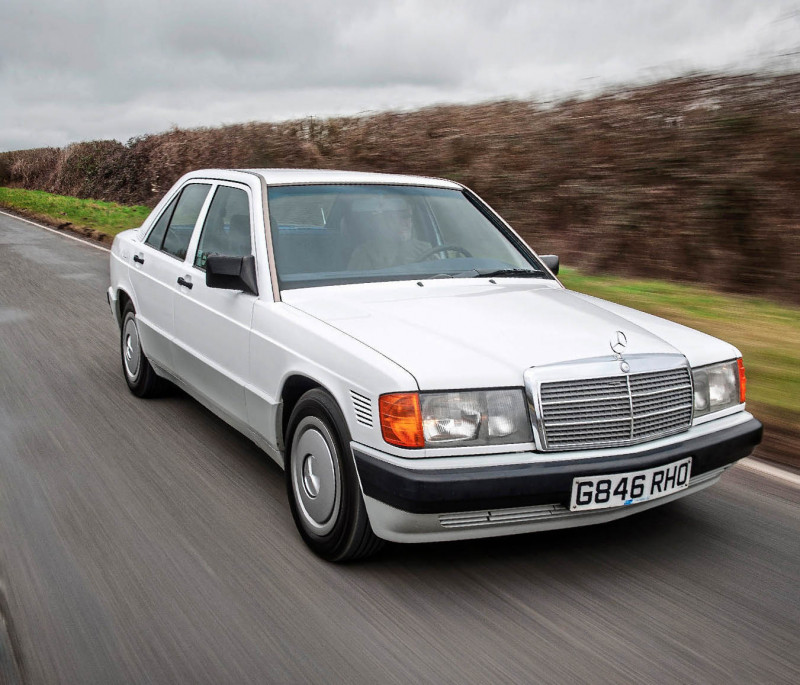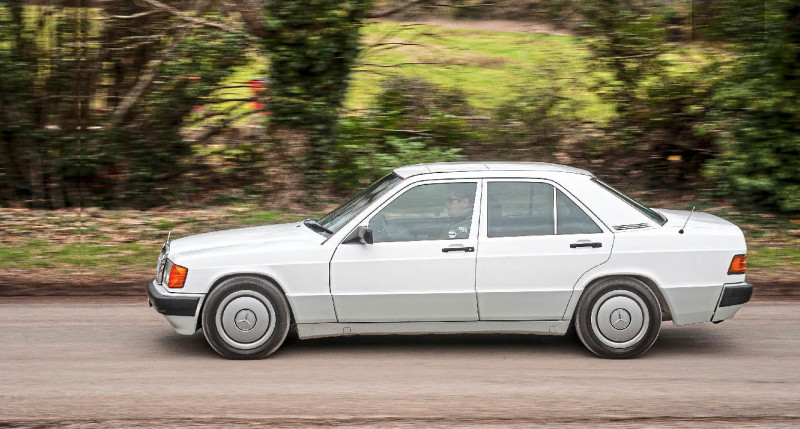Life Cycle - the globetrotting tale of an Australian-owned 1989 Mercedes-Benz 190D 2.5 Turbo Automatic W201

Bought for an Australian couple to explore Europe with, thisMercedes-Benz has lived a life of adventure from the start.
Words RICHARD MASON
Photography LAURENS PARSONS
THE LIFE STORY OF A 1989 Mercedes-Benz 190D 2.5 Turbo Automatic W201
Toured Europe, cosseted by a codebreaker, now a classic.
September 1989 – Penny and Andrew Torok place an order for a new Mercedes-Benz 190TD
Australians Penny and Andrew Torok decided to visit their European roots for lengthy periods – and needed a car to transport them and their luggage. Penny explains. ‘It was 1989 and we were living in Melbourne, but we wanted to travel – and rent rather than staying in hotels. As it turned out, we spent the next 32 years driving all over Europe.

‘We needed a reliable, comfortable car, and being able to buy a Mercedes in Australia and then pick it up in Germany was convenient. Lanes Motors of Melbourne guided us through the purchase. The specification was vital, as we were going a long way. We did 300,000 kilometres in all – we chose left-hand drive because the majority of the time would be in Europe. European car park barriers and motorway tolls are easier to use if the steering is on the left.’

February 1990 – BeBe arrives
Penny and Andrew arrive in Germany, eager to get started on their holiday of a lifetime. ‘The registration of our Mercedes was BB-766 F, so we called her BeBe using the German pronunciation. A Mercedes employee in a white coat conducted the handover process. He showed us how to check the oil and water, as well as pointing out where the fuses were including the spares. We inspected the body to make sure there were no dents or scratches, checked the boot to make sure the spare tyre was present, then moved to the interior, where we learned how to adjust the seats and where the controls are. Next was how to select reverse gear, a slightly complex process on a manual. Ah, but surely we’d ordered an automatic? Our instructor announced, “This is a manual,” as if this was what we expected.

‘At the time of our order, automatic was standard on the 2.5 turbodiesel – but now, five months later, it had become an optional extra. My copies of the order sheets proved we’d specified and paid for an automatic, and told them that’s what we expected to collect. Fortunately, Mercedes agreed to supply the correct car and not to charge extra, but this would take three weeks to slot into their production schedule. Meanwhile, they agreed to lend us a car.

‘We arrived at the factory on the rescheduled day to see BeBe resplendent in her white paintwork. However, whilst present in the wrong car, the central locking we’d specified was now missing in the right car. We decided not to say anything – it would only cause further delay.’
Andrew was born in Hungary, so that was the Toroks’ first destination. Penny recalls, ‘We left Sindelfingen for a 600-mile drive, via Munich and Vienna and eventually to Budapest, although not all in one go. Along the way, the three-pointed star on the bonnet was stolen. We bought a replacement, but kept it in the glovebox. After some time in Hungary, we headed to Italy. Andrew and I always shared the driving; I’m a good navigator and Andrew is a good driver, so on regular roads Andrew drove and I navigated; on the motorways, where directions are simpler, I drove and Andrew often fell asleep.

‘BeBe was so comfortable and lovely to drive – the ideal car for our journeys. Eventually we arrived in Florence and stayed a month, learning Italian. Andrew speaks German and, of course, Hungarian, and I speak French, but neither of us knew Italian – or that we we’d end up living in Italy. After Florence, we decided to continue our language studies on the Isle of Elba for a month, with BeBe taking her first ferry trip, and for the rest of that summer and autumn we were based in northern Italy.
We lived in the tiny village of Airole, up in the mountains, a nine-minute drive from the French border – and BeBe got a lot of attention, because in those days its was unusual for the locals to see a Mercedes rather than the ubiquitous Fiats. Being so close to the South of France meant lots of trips across the border, including one to Monaco. We were still driving on German tourist plates, which was only allowed for six months without paying sales tax. By October that time was almost up, so we moved on to my cousin Phyl’s, staying at her home in Hampshire. We registered the Mercedes in the UK, paying £3355 for car tax and VAT – a lot of money back then.’
Following that, Penny and Andrew returned to Budapest for the winter, renting a flat on the outskirts. Penny recalls, ‘This was about a year since the end of communism, so the Mercedes was a rare sight. Nevertheless, there was no envy or risk of damage to BeBe; people were just interested in what was an unusual car to them. There was a great community spirit and it was easy to make friends; we loved living there, with all the culture and so much to see. One thing we thought interesting were the street signs telling you how to park; sometimes the sign would show “angle parking”, in which the front or rear had to be up on the pavement.
‘We spent these years criss-crossing Europe. The Mercedes was reliable and with a network of Mercedes-Benz garages we could always keep up with the servicing. The highlights were a drive to Greece in April 1991, the many visits to Phyl in Hampshire and a trip to London in 1992. Others included tracing the source of the Danube in the Black Forest and following in the tracks of Napoleon’s army in its historic advance towards Russia.
‘Later we returned to Italy for more fine food and to enjoy the coast along to Sicily, where we watched Mount Etna belch smoke and ash.’ The photo at top right shows BeBe looking almost two-tone black and white. ‘I took the photo,’ explains Penny. ‘It was 1993, somewhere in Poland – it was winter, with a lot of coal dust on the road which was mixing with the snow. As we drove along, this mixture was sprayed on the car, eventually obliterating the headlights – at first we thought they’d failed, but it was just all the muck caked on them. When I took the photo, Andrew was halfway through washing BeBe.’
Penny and Andrew then chose another Italian base, this time the mountain village of Badalucco. Penny recalls the vertiginous house they rented over several years. ‘It’s amazing, but we were the first foreigners to settle there, although it was always only going to be temporary and as a base. Nevertheless, the locals treated us so well and they took a great interest in BeBe. Getting BeBe near to our house was quite perilous – our’s was on the side of a mountain, near the top, and the nearby car park wasn’t really big enough to turn round in. So we would drive towards the car park, then select a spot in which to turn round and reverse the rest of the way, hoping we wouldn’t fall off the road down the cliff.
‘Our son became desperately ill in February 1994 and we returned to Australia urgently, leaving BeBe in Budapest. When our son was well enough for us to leave for a short while, we flew back to Budapest. We collected the car and all the belongings we had left there, drove to Italy and the house in Badalucco, and did likewise there, then drove to England where we packed everything up to be sent home. We parked BeBe with Phyl and hopped on a plane back to Melbourne – and all that in the space of about ten days. The air hostess on the plane home was so impressed she gave us a bottle of champagne.
‘It was not until 1997 that we were reunited with BeBe. Luckily, Phyl had a large property and kept the car in a warm, dry stable. Knowing that machinery needs to be used to keep it working properly, Phyl had arranged for BeBe to be driven short distances regularly. Phyl was a very special person indeed. As a Women’s Auxiliary Air Force officer, she was working in Churchill’s War Room, plotting where the German submarines were so the ships coming from the USA could be protected a little bit. That information, of course, came from Bletchley via the Enigma breakthrough. Phyl was even more important during the D-Day landings, because she was one of the very few who knew when and how the invasion would take place. She was given the MBE for her work and later the French gave her the Legion of Honour.’
Penny and Andrew’s visiting reduced to about three months a year because of the duties of family life in Australia. These are Penny’s lasting memories of the next 25 years: ‘With this new routine we had BeBe serviced by Fairview Motors, a garage local to Phyl. We had no large bills, just consumables, and no need for winter tyres any more. From 1997, we limited our visits to just France and Italy.
‘We took Phyl and her husband John on a European jaunt in summer 1998; visiting the D-Day landing sites was a highlight. Later, the aircon broke down in Italy – not the most comfortable place for it to happen. I have a bill dated 19 June 1998, from a Mercedes place in Monteriggioni who patched it up, much to Phyl and John’s relief.
‘We were in the Pyrenees in 2001, driving down a narrow road, and Andrew moved to the right to allow an approaching car room, because that car was obviously worried about the steep drop on the other side. Our two right wheels went into the gutter with a hell of a crash and we slid some 50 yards down the hill. Several people stopped to see if they could help. We thought BeBe must be seriously damaged underneath, so we asked if someone could ask at a service station for help. We were waiting quietly on the side of the road when an electricity repair truck appeared from up the hill and about six blokes hopped out to see what had happened.
They saw the kangaroo on the back window and all said: “Thorpedo!” and “Kathy Freeman!” (Australian athletes from the 2000 Sydney Olympics), then got on all four corners of the car and lifted it back onto the road. Everyone cheered just as the tow truck arrived.
‘The mechanic decided BeBe would be safe enough to drive to the service station, with the tow truck and the electricity truck as escorts. There, with the car up on a lift, the only visible damage was a longish scratch along the sheet of metal that was protecting the underside of the car – proof of just how tough and well-built BeBe is. The only other mishap was on the Embankment in London in 2009.
Andrew was avoiding another car and glanced a traffic island, bursting the front and rear tyres; poor Phyl was in the “death seat” in the front. We deposited her in a handy nearby pub while we dealt with the problem, which took a couple of hours or more.
‘A significant journey was in 2014, from Budapest to Romania, Bulgaria, Albania, Bosnia Herzegovina, Croatia and Austria – almost a huge circle. This brilliant trip was only spoilt at some borders by having to buy a Green Card, even though we had UK insurance. In Albania we were struck by the amount of cars on the road that were similar to BeBe – scores of them. Many of the roads there were full of pot holes, though.
In 2017 we discovered Cornwall’s narrow lanes. We were there to visit King Arthur’s castle at Tintagel, and the location where they filmed Doc Martin – Port Isaac. Our last visit was in 2022 when, not getting any younger, we knew it was our final driving trip. Today there are many parts of Australia we want to see instead, so we have just purchased an electric Volvo.”
October 2022 – Julian Webb is given BeBe
Julian Webb became the second owner in 2022, and he has also racked up thousands of miles of European driving. ‘I used to drive a hospitality truck for Formula 1 and met many F1 world champions in my line of work. I always remember Michael Schumacher, because he was fond of marmalade – we always had to make sure we had a supply.
‘I love Mercedes; I had a 1989 300 SEL V126 and regretted selling it. For over 20 years I’ve lived near to where Phyl lived. She kept the Toroks’ 190D W201 in her barn and I’d see it over the years. I was curious as to what it was doing there, and when Phyl gave me the the back story I told her I’d be interested in buying it.
‘In August 2022, Penny and Andrew arrived to celebrate Phyl’s 101 birthday, only for Phyl to die a week before they arrived. They told me their long-distance road trips were behind them now. Much to my surprise, they gave me the car because I liked it so much. They had such a passion for the car, I was quite moved. It has wanted for nothing. I feel I owe it to them to keep it up; it really is in good condition, despite the 186,000 miles on the clock.
‘I’ve just treated it to a three-day valet – everything – because I want it to be pristine. The bodywork is exceptional – no stone chips, just a tiny dent in the nearside rear passenger door which will be fixed. The radio doesn’t work and the aerial is stuck. I have the original purchase documents showing the radio cost £270, a lot of money then. The fan has also packed up, as well as the air-conditioning… and maybe the suspension bushes need replacing.
‘You know, the more I use it, the more it’s growing on me. I’m taking it to the 40th Anniversary Celebrations for the W201 at Mercedes-Benz World on the first of October, organised by the Mercedes-Benz Club; it might be the only turbodiesel there. This model wasn’t sold in the UK because of the technical difficulties in making it right-hand drive due to the turbo location and the steering. I really owe it to the Toroks for treasuring BeBe as they have… although the three-pointed star is no longer in the glovebox – it’s back on the bonnet.’

She kept it in her barn and I was curious about what it was doing there
Some Albanian roads leave something to be desired, 2014 BeBe’s travels extended to a Cornish touring holiday in 2017 The more Julian drives the Merc, the more he warms to it Julian’s keeping the car tip top – it’s just had a three-day valet Not only Albania has bad roads; on a Cotswolds holiday in 2022.
Current owner Julian was kindly gifted the car by the Toroks After suffering a puncture on the Embankment, London in 2009

We eventually covered 300,000 kilometres in all, the majority in Europe
Caked in coal dust-tainted road dirt in Poland in 1993 Toroks rejected first car Merc supplied with wrong gearbox Engine is still strong, with 200,000 miles in its sights No aircon in Italy was a sticky moment; 1998 in hilly Badalucco Model was not available in the UK, but its life brought it here.
The Merc spent the winter of 1993 back in Budapest Andrew and wife Penny during a visit to London in 1992 The 186,000-mile Mercedes continues to be cherished.
‘BeBe’ the Benz was ordered in Australia, picked up in Germany On a memorable drive to Greece in 1991, seen here in Meteora Andrew Torok, original owner, with the car in Budapest, 1990

